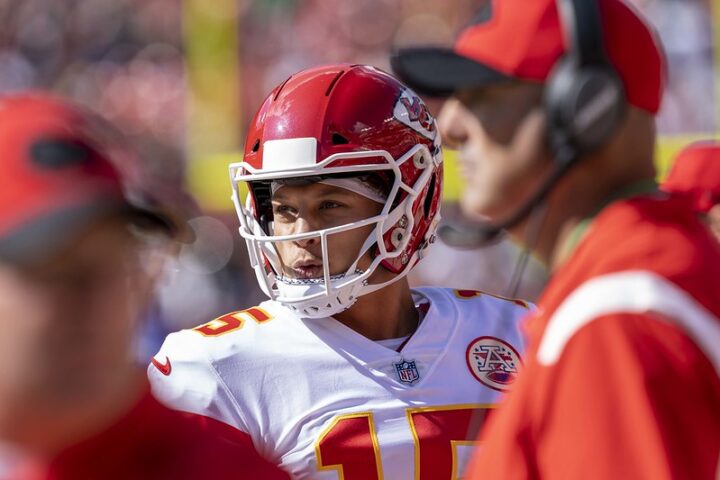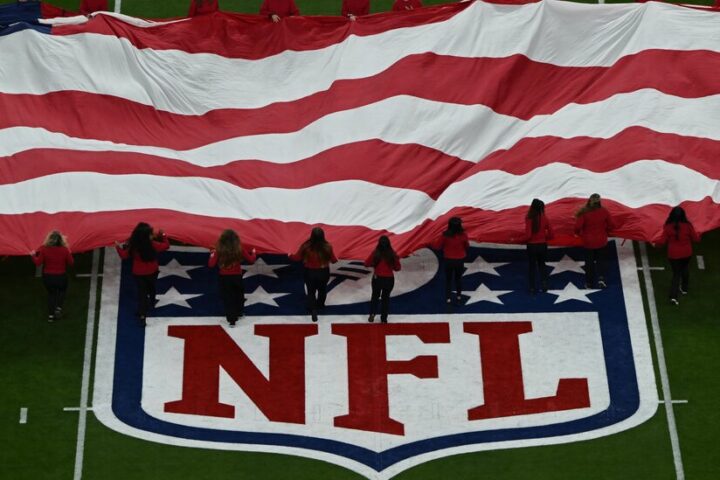Week 4 in the NFL was a good deal more exciting than Week 3, and we learned meaningful things about the teams that played this weekend, as opposed to last weekend. As storylines evolve, we’ll get a better handle on what it means that some of the best quarterbacks in the NFL, at least historically, aren’t putting up historic numbers. But we do get some concrete answers on the Buffalo Bills, Carson Wentz, the Pittsburgh Steelers, and regression. Let’s talk about it.
The Buffalo Bills Showed in Week 4 That They Are Back
I mentioned in my Week 4 QB rankings that it didn’t matter to me that the Bills were winless in one-score affairs over the last two years because they were simply so good that one-score games were rare for them. Lo and behold, they come back from a multiple-score deficit against a great team to win a one-score match. These things are more likely random than anything else.
Another feature of randomness — drops and fumbles. In the first half, the Bills were plagued by drops and fumbles. Few are suggesting that Josh Allen doesn’t have a fantastic supporting cast; he has a great group of players around him. But he looked let down by the team around him. But statistical regression snapped back around, and he started hitting on his good throws. That, plus a reinvigorated Buffalo pass rush, meant the comeback was in the cards.
Something else to keep in mind — the Bills’ offense was fun to watch, and it’s a credit to Allen that he was able to pull off this comeback. But it’s worth noting how fragile the Ravens are.
Losing Rashod Bateman — now “day to day” with a foot injury — partway through the game crippled the offense. It’s essentially him and Mark Andrews helping out Lamar Jackson, and it needs to be much more than that.
Wentz Watch
Wentz’s meteoric rise and fall are a good reminder that there are a dozen pass/fail skills for quarterbacks to have if they’re going to be successful in the NFL, and they are dizzying both in degree of difficulty and complexity. While Wentz has a few issues plaguing him right now, including post-snap diagnosis and anticipation, his primary issue seems to be quick decision-making.
These are three different but related skills, and it’s important to note that his excellent 2017 season was driven in part by how much more quickly he was getting rid of the ball, an issue he had as a rookie and throughout college.
Over the past several years, Wentz has regressed to his previous form, making him vulnerable to teams with good blitzing or strong four-man pressures — something the Cowboys feature with Micah Parsons and Demarcus Lawrence.
MORE: Week 5 NFL Power Rankings
Now, a reasonable offensive line looks much worse than it is as Wentz holds on to the ball and takes sack after sack. He leads the league in sacks taken despite a reasonable pass-protection unit — not at the level of the Eagles or Lions, but more functional than several lines around the league.
Of course, it would be reasonable to wonder if that’s the case after Dallas whooped the offensive line in under a second multiple times throughout the game. But overall, Wentz has done a poor job reacting to pressure and often holds on to the ball instead of throwing it away or finding a pressure valve in a checkdown.
At the very least, this reminds me vaguely of Tim Tebow, not because Wentz is as inaccurate as Tebow, but because they both fell on their habits. Tebow spent every offseason doggedly attempting to fix his throwing motion. Every year, he would show up in the preseason with a more compact throwing motion only to lose it several weeks in. It’s hard to break habits.
Pickett Pride
The Steelers are probably not any better with Kenny Pickett, but they are definitely much more interesting. A lot will be made of the fact that Pickett only threw completions or picks in his debut after Trubisky was benched before the second half, but that’s not what’s going to drive the conversation surrounding him as he enters a tough stretch (Bills, Buccaneers, Dolphins, and Eagles).
His interceptions weren’t his fault in the most meaningful sense, though his ball placement played a role in two of them. Rather, Pickett’s risk-reward tolerance seems to be a bit off, and he needs to make better decisions about which risky throws he’s going to make and whether the juice will be worth the squeeze.
On top of that, the offense is going to have to change. Mitchell Trubisky was throwing almost entirely to the sidelines, and Pickett doesn’t quite have the arm strength to make an offense out of sideline throws. Scheming short throws open with crossers and choice routes might be the best option in the short term to protect him from himself.
I’m not sure Pickett is the answer in Pittsburgh, but he’s much more interesting for them than Trubisky.
Eagles Tell Us About the Rest of the NFC
Maybe it’s unfair to the Philadelphia Eagles, but right now, they seem to be the best team in the NFC, and that tells me more about the NFC than it does the Eagles.
They aren’t just 4-0, which helps us come to that conclusion, but they also have the best combined offensive and defensive value in the passing game, generate more expected points on both sides of the ball, and aren’t reliant on fluky turnovers — they just happen to get a good amount of them and lead the league in defensive takeaways per drive.
The Eagles are definitely good, both in terms of surface-level performance and deeper analytical numbers, but elite teams typically play more consistently than Philadelphia has, with better floor-level play. When thinking about the historical elite teams in football — the Chiefs and Rams over the last few years, the Bills this year, and so on — they have had big wins over quality opponents with consistent performances throughout.
It’s important to see the incredible comebacks that the Eagles have had and the dominant wins they’ve had, but there’s something holding me back from judging them as an elite team on par with those other elites from recent seasons.
This take is going to look progressively dumber over time as they dominate their weak schedule (next up: a collapsing Cardinals, a Cooper Rush-led Cowboys, a Pickett-led Steelers and Washington. And a Football Outsiders future strength of schedule rank of 32nd).
Still, they’re almost certainly the best team in the NFC, so who cares?
Red-Zone Regression
One way to tell if a team is about to explode in points is to see if they’ve entered the red zone quite a bit but haven’t converted. This typically regresses quickly to the mean, so we should see some surprising point production from those teams.
That means the Vikings, Raiders, Colts, and Rams should score a chunk of points soon and it will look like a surprise to a lot of people. Don’t be surprised.
On the other side, the Steelers, Titans, and Buccaneers all have a high red-zone percentage but few red-zone trips. That will correct itself too, though I think the Buccaneers may be a unique case as they should enter the red zone far more often going forward with their receivers returning to the field of play.
Running Renaissance
The Lions, Browns, Eagles, Seahawks, and Ravens all have some of the most explosive offenses in the NFL and all are led by their running game. The Eagles and Ravens are led by running threats at quarterback, so there’s some level of expectation there. But the Lions, Browns, and Seahawks are somewhat surprising in this regard.
Steven Ruiz wrote about this at the Ringer, which serves as a good complement piece to my idle musings about what’s holding NFL offenses back. The success of NFL running games may teach executives the wrong lessons about how to build a good team in the long run, but without many high-level quarterbacks, at least right now, this may be their only option. I expect the Lions in particular to regress, however.
Expected and Actual yards per carry given defender position at time of handoff
Going to go out on a limb and say that the James Conner and, especially, Chase Edmonds deals have already not aged well pic.twitter.com/gRgoxjItiO
— Computer Cowboy (@benbbaldwin) October 4, 2022
Final Thoughts
- Micah Parsons is nuts. Usually, when a player “has the ability to play multiple positions,” it usually means they can play four different positions poorly. Parsons legitimately plays like an elite edge rusher and an elite linebacker. The Cowboys recognize that this choice isn’t much of a choice at all and have been rushing him off the edge.
- Trevon Diggs was a risky all-or-nothing cornerback last year that resulted in tons of yards given up with a nice bundle of interceptions that came with that. His actual value was well worth debating given that dichotomy. This year, he’s just a good, possibly great, corner. It’s cool to see.
- It’s been a while since I’ve seen a team as excellent defensively and incompetent offensively as the Carolina Panthers. It reminds me of the 2009-2010 Jets.
- The Chiefs’ defense seems like it’s on the verge of getting a lot better, and once that happens, they should be just as exciting to track as the Bills are.
- I’m still skeptical of Geno Smith, and his production numbers remind me of the fact that Jimmy Garoppolo is an advanced stats wizard but somewhat of a mediocre quarterback. I hope I’m wrong, Smith is fun to root for.
- The Raiders were favored against the Broncos, so the bettors know what they’re doing, but it’s still embarrassing for Denver that they lost to Las Vegas.
- This draft class of quarterbacks may turn out to be a good deal more interesting than we thought. Bailey Zappe and Pickett were both fun to watch, and we may soon see Desmond Ridder take over for Marcus Mariota if Arthur Smith becomes sufficiently frustrated.



